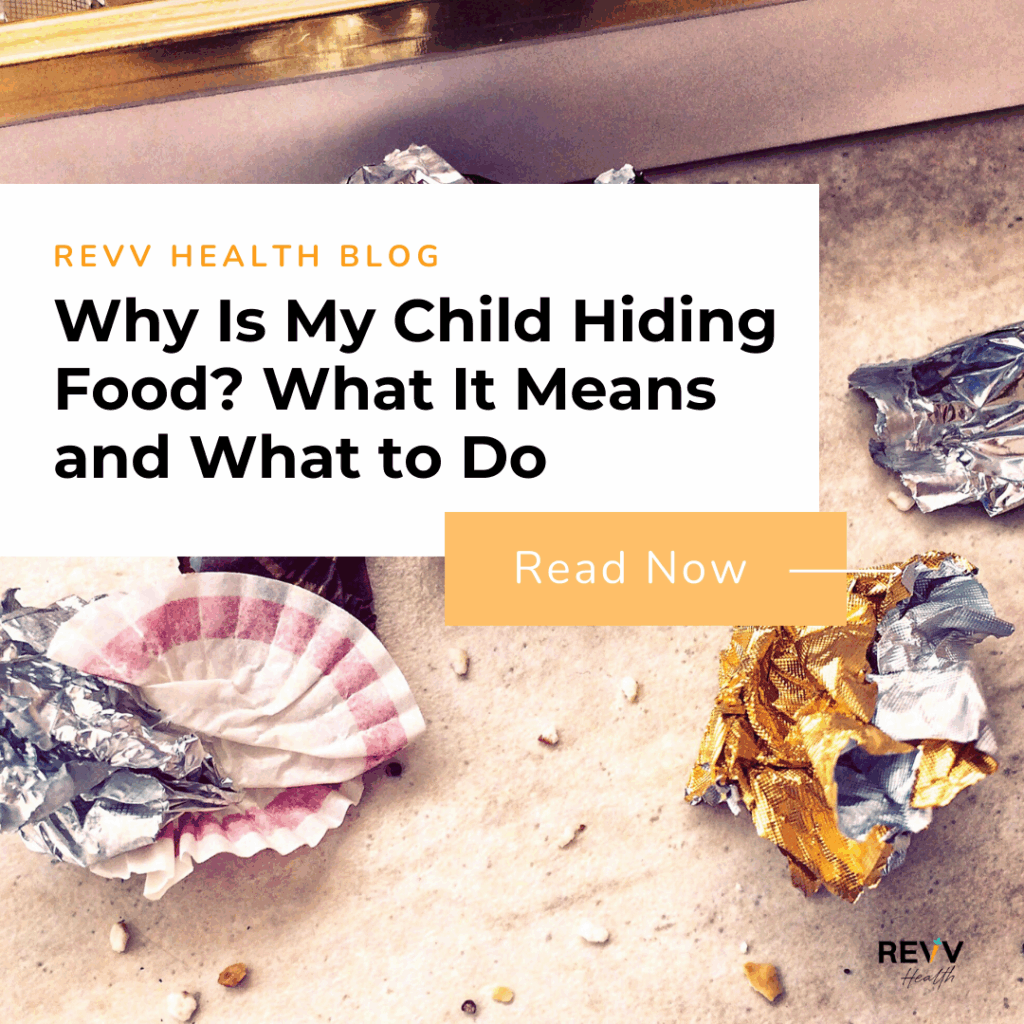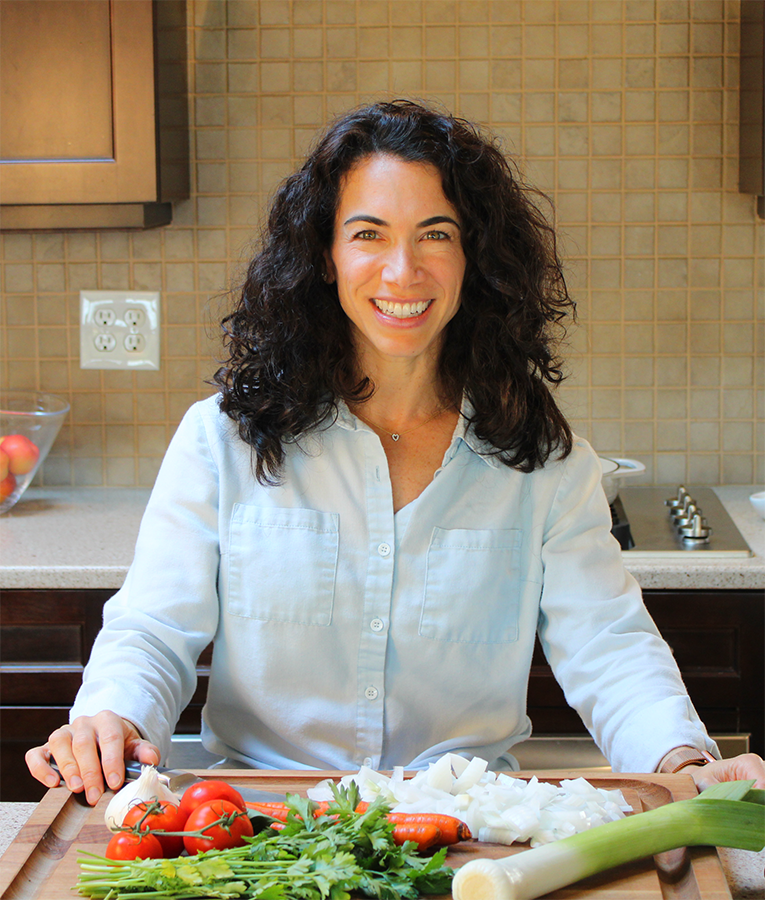Short on time? Listen to this article on-the-go:
You’re changing the sheets, picking up laundry, or grabbing something from under the bed… and there it is.
Wrappers. A stash of snacks. Maybe even food that’s long expired!
Your heart skips. You might feel confused, worried, or even a little angry!
Why are they hiding food? Are they sneaking it from me? What does this mean?
If this has happened in your home, you’re not alone. And no, it doesn’t automatically mean something is wrong with your child, or with your parenting. Deep breath: I’m here to help.
Welcome! I’m Marissa, a dietitian who guides families through food and body image concerns, especially when eating starts to feel emotional, confusing, or out of control. And I’ve had many thoughtful, loving parents sit across from me, wondering what to do after finding hidden food.
Food hiding can feel like a red flag (and sometimes, it is). But more often, it’s a protective behavior. It’s a signal that something in your child’s world doesn’t feel quite safe or regulated when it comes to food.
In this article, I’ll help you understand:
- What food hiding actually is (and what it isn’t)
- The science behind why it happens (even in well-fed, loving households)
- And how to respond in a way that protects your child’s health and relationship with food (and your relationship with your kiddo, to boot)
Let’s dive in!
What is food hiding, really?
Food hiding (or eating in secret) can take many forms:
- A child might tuck candy under their pillow
- A teen might wait until everyone’s asleep to eat in the kitchen alone
- Some kids hoard snacks in drawers or backpacks
- Others eat quickly when no one is looking, and pretend they didn’t when confronted
No matter what it looks like, food hiding almost always involves a sense of secrecy or urgency. Whether they’re stashing, sneaking, or eating in private, the behavior is rarely random.
It’s easy to assume the worst when you discover it. But food hiding is often a coping strategy, and a way some kids feel safe, soothed, or in control.
As an example:
- Younger kids might hide Halloween candy because they’re afraid it’ll be taken away.
- A child who’s heard that sweets are “bad” might sneak them so they aren’t shamed when eating them.
- Teens often hide food if they’re worried about being judged, especially if weight, eating, or appearance has been a focus in the home or elsewhere.
In most cases, food hiding is a signal. It’s not an act of defiance or dishonesty, but rather, your child expressing an unmet need.
This is also a good moment to check in with yourself.
If you had hidden food as a kid, how would your parents have reacted?
Would they have responded with curiosity…or control?
It’s okay if this triggers or brings up something for you. Try to hold space for those feelings while also showing up differently for your child.
The research behind why kids (and teens) are hiding food
Many parents feel confused or even alarmed when they discover their child is sneaking or stashing food.
But research shows that hiding food isn’t rare. In fact, it’s very common.
One U.S.-based study of children ages 5 to 12 with higher body weight found that nearly one-third of parents reported food hiding behaviors in their kids (source).
1. Food insecurity
Sometimes, it starts with food insecurity. Kids who’ve experienced hunger, unpredictable meals, or poverty may develop what researchers call a “scarcity mindset.” Even in homes where food is now reliable, they may continue hiding or hoarding snacks out of fear that it won’t always be there (source).
When a child’s early environment taught them that food wasn’t guaranteed (whether due to poverty, neglect, or frequent disruptions in care), hiding or hoarding food can become a survival strategy.
This is especially common in children with foster care experience, who may have gone long periods without reliable access to meals. The instinct to stash food often lingers, even after the environment becomes safe.
2. Dieting and other controls around food
In other cases, food hiding emerges in homes where eating is highly controlled or restricted. If certain foods (like sweets or snacks) are seen as “bad” or only allowed occasionally, kids can become more fixated on them. And when they don’t feel safe asking for those foods, they may sneak or hide them instead (source).
When access to certain foods feels limited or loaded with judgment, kids often try to get those needs met in private.
3. Body image struggles
Then there’s shame and body image, which are two powerful emotional drivers behind secretive eating. Some kids feel embarrassed by their hunger or self-conscious about their body, especially if they’ve been teased or compared to others. Hiding food can become a way to avoid being seen (or judged) when eating (source).
4. Stressful environment
Finally, stress at home can also play a role. In households that feel chaotic or unpredictable, kids may stash food simply to have something they can count on. If mealtimes are inconsistent or the environment is emotionally unstable, hiding food can become a way to create some control or comfort in a world that doesn’t feel secure (source).
What food hiding is not
It’s easy to panic when you discover hidden food.
Your mind might jump to blame… What did I miss? Did I cause this?
Take a breath. This doesn’t mean you’re a bad parent.
Before you spiral into guilt, it helps to understand what food hiding typically isn’t.
1. It’s not a sign your child is manipulative or “out of control.”
Hiding food often serves a pretty important purpose: soothing uncomfortable feelings, avoiding shame, or managing anxiety. Even when it looks defiant, it’s more likely your child is hiding food as a coping strategy than an act of rebellion.
2. It’s not something you caused or failed to prevent.
If guilt is creeping in, that is really common. Many parents wonder if they were too strict or too lenient. But food hiding is complex and rarely tied to one moment or mistake. What matters most right now is what you do next.
3. It’s not a reason to take food away.
Restricting access may seem like a quick fix, but it often deepens the secrecy. A more effective approach is to focus on creating a sense of safety and predictability around food so that your child no longer feels the need to hide it.
Food hiding can feel like a personal attack, but I want to reiterate that it is NOT a reflection of your worth as a parent. Your child does not need more control or consequences. What they really need is a compassionate, curious, and understanding response.
Which brings us to the next section…
How to respond (without making it worse)
If you’ve just discovered that your child is hiding food, take another deep breath.
Yes, your response matters, but it doesn’t have to be perfect. Your only goal is to start building back trust.
1. Stay calm and curious
Instead of jumping to conclusions, try to approach this situation with true curiosity.
You might say in a soft, non-condescending tone: “Hey sweetie, I noticed some wrappers in your room. When you’re ready, can you tell me more about it? I’m not upset at you.”
This opens the door for connection instead of confrontation.
2. Avoid shame or punishment
Reacting with anger, blame, or consequences may only reinforce the secrecy.
You might say: “You’re not in trouble. I care more about how you’re feeling than what you ate.”
Kids who feel judged are much more likely to keep things hidden. What they need now is to feel safe and understood.
Remember, your child isn’t trying to be difficult; they’re just asking for safety in the only way they know how. What they need most isn’t a consequence. It’s more connection!
3. Offer regular, predictable access to food
When food is consistently available, the urgency to sneak or hide it often fades.
You might try saying: “I made sure there’s a snack ready in the afternoon, so that if you’re ever hungry, you don’t have to wait or ask.”
Structure creates security, especially for kids who have felt restricted or anxious around food.
For some families, it also helps to have an “always OK” shelf, drawer, or bin with a few snack options your child can access on their own. No permission needed.
This can include items like granola bars, applesauce packets, crackers, or trail mix.
The idea isn’t unlimited snacking, but rather creating a sense of safety: “There is always food available to me, and I don’t need to hide it.”
This small shift can go a long way in reducing power struggles, building trust, and supporting your child’s internal cues.
4. Check your own language around food and body
Even well-meaning comments about “healthy choices” or “portion sizes” can unintentionally reinforce shame. Over time, kids pick up on which foods feel “safe” to like and which bodies are praised (or not).
You might reflect: “I’ve been thinking a lot about how we talk about food at home. I want to make sure no one feels bad for liking dessert or eating when they’re hungry.”
Small shifts in how you talk about food can help your child feel accepted, not judged, for their appetite and their body.
5. Hold boundaries with empathy
You can guide your child’s behavior while still honoring their emotions.
You might say: “Let’s figure out a way to keep food in the kitchen so it stays fresh, and if you’re ever hungry, just let me know.”
Boundaries work best in the long term when they come with reassurance, not fear. Scolding your child or getting them in trouble won’t help repair the trust that’s needed here.
If you were raised in a “my way or the highway” kind of household, it might feel unfamiliar (even uncomfortable) to take a more collaborative approach.
But here’s the risk: when kids feel controlled, shamed, or punished around food, they often learn to disconnect from their own hunger cues. They stop trusting their body, and they stop trusting you.
And no, it doesn’t mean you need to “let things slide.” Instead, we have to create an environment where your child feels safe enough to be honest with you… even about hard things.
In some cases (especially with kids who’ve experienced food insecurity or foster care), offering a small snack bin in their room can be a helpful bridge. This can give them a sense of safety and autonomy, while still including age-appropriate boundaries (like choosing shelf-stable foods and avoiding perishables that could attract bugs).
You might say, “I want you to always have access to food; it’s okay to keep it here, but let’s put it in the bins so that we’re not attracting ants or mice…etc.”
You can support your child and guide them. These aren’t opposites! They’re part of the same path toward trust.
When to get support, and what kind
Sometimes, food hiding is a passing behavior. But other times, it’s part of a bigger pattern that deserves more attention and care.
Here are a few signs that it might be time to reach out to a professional:
- Your child is hiding food and showing signs of restriction (like skipping meals or avoiding certain foods)
- They express guilt or shame about eating or their body, and/or are wearing bulky clothes to hide their shape
- They seem anxious about food, weigh-ins at the pediatrician, or eating in front of others
- You’ve noticed compensatory behaviors, like excessive exercise or rigid food “rules” they’ve created
- This isn’t the first time you’ve noticed food hiding, and it seems to be happening more often or with more emotional distress.
In addition to connecting with a registered dietitian, it can also be helpful to:
- Talk to your child’s teacher or school counselor to screen for bullying, teasing, or exclusion, especially if body changes or food habits have shifted suddenly.
- Reach out to a licensed therapist, particularly one trained in working with kids or teens, for anxiety support or screening for eating disorders.
(BTW: You don’t need a diagnosis to ask for help. And you definitely don’t need to wait for things to get worse.)
If you’re feeling unsure of what to do next, consider connecting with a registered dietitian who specializes in non-diet work and eating disorders (like me!), especially someone who takes a non-diet, weight-inclusive approach.
That means your child won’t be shamed for their body or food choices. They’ll be gently met with curiosity, compassion, and practical tools to help them feel more at peace around food.
This is the kind of support I offer every day in my work with families. If you’re worried about what you’re seeing and want guidance, I’m here to help.
Final thoughts
Finding out your child is hiding food can be upsetting. It’s okay to feel caught off guard, worried, or unsure of what to do next.
But please know: you are not a bad parent. This is hard. And it can bring up a lot. But none of this means you’ve failed.
You don’t have to be perfect, just present. A calm, curious response can go further than any rule or consequence ever could.
Food hiding is merely a signal, and now, you’re better equipped to respond in ways that can help your child feel safer, not just with food, but with you.
If what you’ve read today resonates, and you’d like expert guidance from someone who understands the nuance of food and body struggles, I’d be honored to support you and your family.
There’s an opportunity right now to build trust. To show your child that they don’t need to hide their hunger, their preferences, or their feelings. That all food is allowed, that their body isn’t the problem, and that they’ll be met with support rather than shame.
Reach out for a free 20-minute connection call to help your child stop hiding food, feel better in their body, and be more connected with you.
You don’t have to figure this out alone.




0 Comments